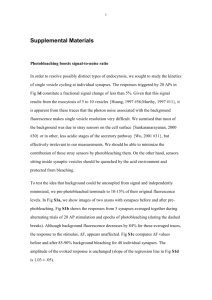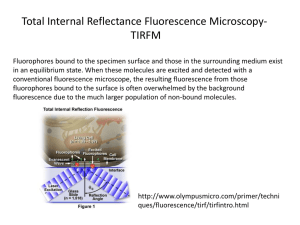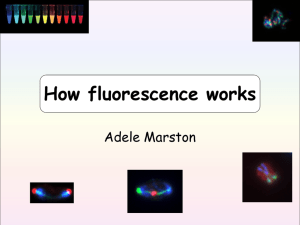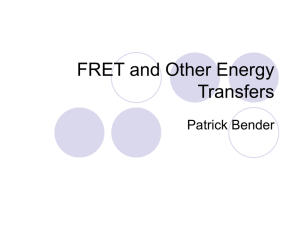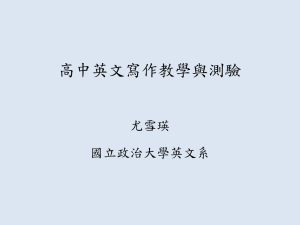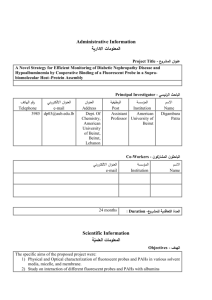For Journal of Fluorescence October 12, 2015 Supporting
advertisement
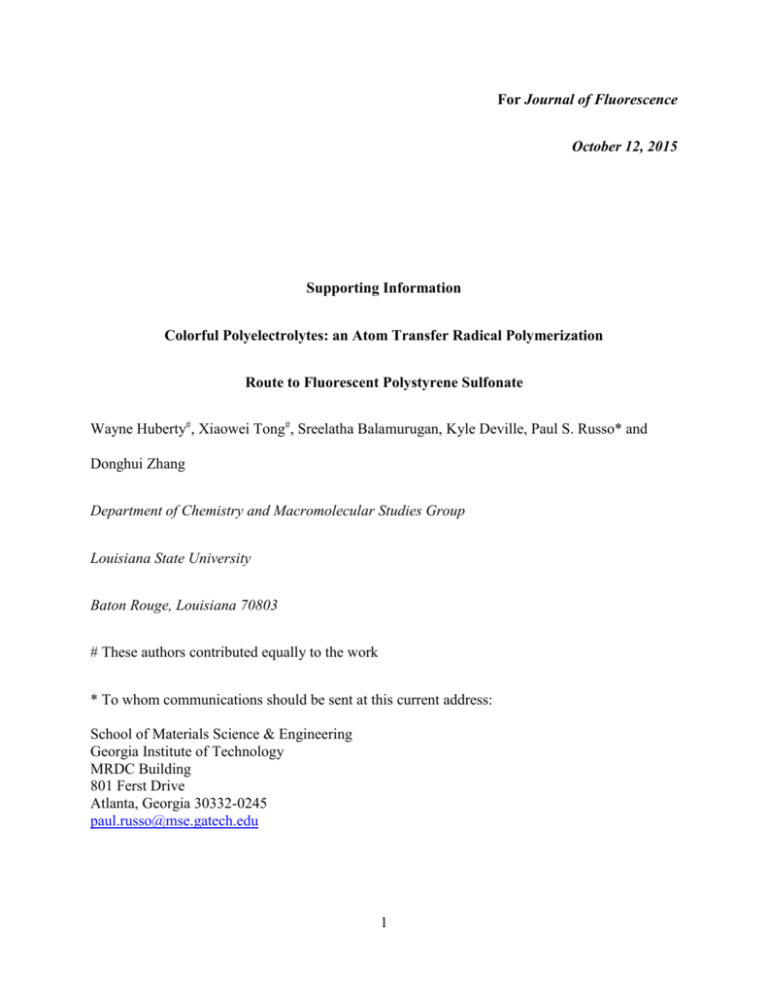
For Journal of Fluorescence October 12, 2015 Supporting Information Colorful Polyelectrolytes: an Atom Transfer Radical Polymerization Route to Fluorescent Polystyrene Sulfonate Wayne Huberty#, Xiaowei Tong#, Sreelatha Balamurugan, Kyle Deville, Paul S. Russo* and Donghui Zhang Department of Chemistry and Macromolecular Studies Group Louisiana State University Baton Rouge, Louisiana 70803 # These authors contributed equally to the work * To whom communications should be sent at this current address: School of Materials Science & Engineering Georgia Institute of Technology MRDC Building 801 Ferst Drive Atlanta, Georgia 30332-0245 paul.russo@mse.gatech.edu 1 GPC/MALS Details Figure 5 from the main article is reproduced as Figure S1-A for convenience. Such a plot has become routine in the age of online light scattering detectors. As noted in the main text, the peaks tail towards the high-elution-volume side of the chromatogram. Figure S1-B shows the same datasets in a concentration vs molecular weight representation. Only for the largest polymer does the shape match expectation. The loops and arcs seen for the smaller two polymers indicate that the same molecular weight was measured more than once while collecting the elugram. Such pathological traces can occur when separation is not based entirely on size exclusion but instead relies partly on interactions with the stationary phase. Light scattering would still report the molecular weight correctly, as long as the composition (and with it, dn/dc) has not changed during elution. Branching or other architectural defects, such as cyclization, that may cause unusual c vs M profiles are not expected from the synthetic protocol used here. Another possible explanation for seemingly poor resolution is column overload; the low molecular weights of these two polymers necessitated more polymer. As an exercise, the concentrations within a given molecular weight range were summed into bins to give a more meaningful representation of the concentration vs molecular weight, Figure S1-C. These results demonstrate that simple and common representations such as Figure S1-A can be misleading. 2 B) 3.0 1.0 2.5 -1 1.2 concentration/10 g·mL 0.8 100:1 2.0 300:1 -4 ILS( =90) /a.u. A) 0.6 100:1 200:1 0.4 300:1 0.2 0.0 6 8 10 1.5 200:1 1.0 0.5 0.0 12 0 Elution Volume/mL 1 2 3 4 5 5 Mw/10 g·mol Figure S1 6 7 8 -1 C) A) Same as Figure 4 in main document. Light 140 traces are of LNaPSS in buffer (200 mM 120 g·mL -1 scattering signal from GPC chromatograph. The 100 concentration/10 -4 NaNO3, 10 mM H2PO4, 2 mM NaN3 at pH 7.5) with monomer:initiator ratio of 100:1 [M]:[I] (blue line), 200 [M]:[I] (red line), and 300 [M]:[I] (black line). 100:1 80 60 40 20 B) Concentration vs molecular weight 0 0 representation. C) Concentrations collected into bins for 100 [M]:[I] sample. 3 5 -1 Mw/10 g·mol 1 Fluorescence Photobleaching Recovery of LNaPSS For a more through description of fluorescence photobleaching recovery (also known as fluorescence recovery after photobleaching) see other literature.2-5 In the modulation detection FPR scheme used here, a fluorescent sample is placed in an epifluorescence microscope and illuminated by a weak laser beam. A Ronchi ruling in a rear image plane of the microscope casts a striped pattern on the sample and a DC intensity signal is measured. Briefly, an intense laser illuminates the sample, destroying the fluorescent molecules not protected by the dark stripes of the Ronchi ruling. An AC signal is created by a tuned amplifier/peak voltage detection circuit when the striped pattern goes into reciprocal motion, causing the illumination pattern to go into and out of phase with the pattern bleached into the sample. The destroyed fluorophores produce no signal but the persevering fluorescent molecules do. Over time, the AC signal decreases due to the diffusion of the fluorescent molecules, decreasing the sharpness of the bleached line produced and the signal loss is fit to Equation 1 𝐴𝐶 𝑠𝑖𝑔𝑛𝑎𝑙 = 𝐴1 𝑒 (−𝐷𝐾 2 𝑡) Equation 1 where A1 is the amplitude, t is time, D is the diffusion coefficient, 𝐾 = 2𝜋⁄𝐿 and 𝐿 = spatial period of the Ronchi ruling. The fit provides a tracer self-diffusion coefficient, different than the mutual diffusion coefficient sensed in DLS; otherwise, the fitting regimen will be very familiar to a DLS practitioner. 4 0.8 10 0.25 0.20 8 0.15 -2 /10 Hz 0.4 0.10 6 0.05 4 0.00 0.0 0.1 2 0.2 5 -2 0.3 0.4 DC / volt Peak AC / volt 0.6 K /10 cm 0.2 2 0.0 -10 0 10 20 30 0 40 t/s Figure S2. Recovery for 4% wt. FNaPSS (Mw= 88,500 and PDI = 1.3) in 0.15 M NaCl. The red line is a single exponential fit to the data and the blue line is the measured intensity. The inset shows a linear dependence on squared spatial frequency. Figure S2 shows a typical decay for ATRP-produced LNaPSS with ample AC signal at 4% w/w of LNaPSS in water. The blue line in Figure S2 shows the measured intensity of fluorescent signal. The drop to zero volts at time zero reflects closure of a shutter to protect the photomultiplier tube during the bright bleaching pulse. A period of almost 10 seconds was required before stable DC signal was again observed after re-opening the shutter, and the postbleach DC signal is just a few percent lower than the initial. Such shallow photobleaching is desirable in FPR measurements because it reduces heating and the production of potentially damaging byproducts of the photobleaching reaction. Ignoring AC signal points during this settling time, a single exponential fits the AC data well, providing the decay rate. 5 Additional Images 6 A B Figure S3. Images of LNaPSS (5 μL drop of 5 g/L LNaPSS, 0.1 M NaCl, dried in 42 % relative humidity). A: Differential interference contrast image overlaid with a fluorescence pseudo-colored image using nearest neighbors constrained iterative deconvolution. B: Pseudo-colored laser confocal compilation image of 16 images of 2 μm difference in the zplane. The image was deconvolved using a nearest neighbors algorithm.1 7 Movies Movie 1 This movie is a video of a differential interference contrast image overlaid with a fluorescence image using nearest neighbors constrained iterative deconvolution and false color added. movie 3d volume_4.wmv 8 Movie 2 This movie is the same as Movie 1 but it is a closer look at the salt crystal. movie 3d volume_2.wmv 9 References 1. Monck, J. R. O., A. F.; Keating, T.J.; Fernandez, J.M. The Journal of Cell Biology 1992, 116, 745-759. 2. Huberty, W. Synthesis of Flourescent Poly(styrene sulfonate). Louisiana State University, 2012. 3. Russo, P. Q., J.; Edwin, N.; Choi, Y.W.; Doucet, G. J.; Sohn, D., Fluorescence Photobleaching Recovery. In Soft Matter: Scattering Imaging and Manipulation, Pecora, R. and Borsali, R., eds. Springer, New York, 2008. 4. Lanni, F.; Ware, B. R. Rev. Sci. Instrum. 1982, 53, (6), 905-908. 5. Zero, K.; Ware, B. R. Journal of Chemical Physics 1984, 80, (4), 1610-1616. 10


